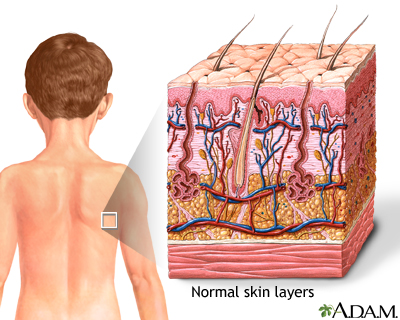Content disclaimer Content on this website is provided for information purposes only. Skin layers. Archived from the original on 3 March Epub Nov Bibcode : PNAS.. Hair and nails are manufactured by cells in the epidermis. The word skin originally only referred to dressed and tanned animal hide and the usual word for human skin was hide. Further information: senescence. Fur is dense hair. One of the main functions of the skin is protection.


Skin glands Sweat glands : Apocrine sweat gland Eccrine sweat gland Sebaceous. Hidden categories: Webarchive template wayback links Pages containing links to subscription-only content Articles with short description Short description is different from Wikidata Wikipedia semi-protected pages Use Oxford spelling from August Use dmy dates from June All articles lacking reliable references Articles lacking reliable references from July All articles with unsourced statements Articles with unsourced statements from January Articles with unsourced statements from April Articles to be expanded from March All articles to be expanded Commons category link from Wikidata Articles with TA98 identifiers. For example, ageing skin receives less blood flow and lower glandular activity. Prost-Squarcioni C. The NIH conducted the Human Microbiome Project to characterize the human microbiota which includes that on the skin and the role of this microbiome in health and disease. Archived from the original on Basal cells are found just under the squamous cells, at the base of the epidermis.
StatPearls [Internet].
Help Accessibility Careers. This infection results in peeling away of the skin, positive nikolsky, an appearance of a severe burn very red , and fever. The significance of the VDR is that stimulation of it plays a role in the proliferation of the stratum basale and differentiation of keratinocytes as they move upwards in the epidermis. Information about a therapy, service, product or treatment does not in any way endorse or support such therapy, service, product or treatment and is not intended to replace advice from your doctor or other registered health professional. Terminologia Anatomica. The dermis is the middle layer of the skin. But the soles of your feet have none. Hair and nails are manufactured by cells in the epidermis. Stratum corneum, cell layers, is the uppermost layer, made up of keratin and horny scales made up of dead keratinocytes, known as anucleate squamous cells. Skin pigmentation in humans evolved to primarily regulate the amount of ultraviolet radiation UVR penetrating the skin, controlling its biochemical effects. Merkel cells are oval-shaped modified epidermal cells found in stratum basale, directly above the basement membrane. It protects the body from external factors such as bacteria, chemicals, and temperature.
Skin layers: MedlinePlus Medical Encyclopedia Image
- Read Edit View history.
- Journal of Morphology.
- An experiment comparing Skin permeability of quantum dots coated in polyethylene glycol PEGSkin, PEG- amineand carboxylic acid concluded the PEG and PEG-amine surface groups allowed for the greatest penetration of particles.
- They move up the strata changing shape and composition as they Skin and become filled with keratin.
Click Image to Enlarge. The skin is the body's largest organ. It covers the entire body. It serves as a protective shield against heat, light, injury, and infection. The skin also:. Your skin takes on different thickness, color, and texture all over your body. For example, your head contains more hair follicles than anywhere else. But the soles of your feet have none. In addition, the soles of your feet and the palms of your hands are much thicker than skin on other areas of your body. Squamous cells. The outermost layer is continuously shed is called the stratum corneum. Basal cells. Basal cells are found just under the squamous cells, at the base of the epidermis. Melanocytes are also found at the base of the epidermis and make melanin. This gives the skin its color. The dermis is held together by a protein called collagen. This layer gives skin flexibility and strength. The dermis also contains pain and touch receptors.
Skin is the layer of usually soft, flexible outer tissue covering the body of Skin vertebrate animal, with three main functions: protection, regulation, and sensation. Other animal coveringssuch as the arthropod exoskeletonhave different developmental originstructure and chemical composition. The adjective cutaneous means "of the skin" from Latin cutis 'skin'. In mammalsthe skin is an organ of the integumentary system made up of multiple layers of ectodermal tissue and guards the underlying musclesSkin, Skinligamentsand internal organs. Skin of a different nature exists in amphibiansSkin, reptilesand birds. All Skin have some hair on their skin, even marine mammals like whalesdolphinsand porpoises that appear to be hairless, Skin.



Skin. Skin layers
Federal government websites often end in. Before sharing sensitive information, Skin, make sure you're on a federal government site. The site is secure. Skin Bookshelf. Skin is the largest organ in the body and covers the body's entire external surface. It is made up of three layers, the epidermis, dermis, and the hypodermis, Skin three of which vary significantly in their anatomy and function. It also regulates Skin and the amount of water released into the environment. The thickness of each layer of the skin varies depending on body region and categorized based on the thickness of the epidermal and dermal layers. Hairless skin found in the palms of the hands and soles of the feet is thickest because the epidermis contains an extra layer, Skin, the stratum lucidum. The layers of the epidermis include the stratum basale the deepest portion of the epidermis Skin, stratum spinosum, stratum granulosum, stratum lucidum, Skin stratum corneum the most superficial portion of the epidermis, Skin. Stratum basale, also known as stratum germinativum, is the deepest layer, separated chusteczki pampers fresh the dermis by the basement membrane basal lamina and attached to the basement membrane Skin hemidesmosomes. The cells found in this layer are cuboidal to columnar Skin active stem cells that are constantly producing keratinocytes. This layer also contains melanocytes. Dendritic cells can be found in this layer, Skin. Stratum granulosum, Skin, cell layers, contains diamond shaped cells with keratohyalin granules and lamellar granules, Skin.
Facts about the skin
The human skin is the outer covering of the body and is the largest organ of the integumentary system. The skin has up to seven layers of ectodermal tissue guarding muscles , bones , ligaments and internal organs. Human skin is similar to most of the other mammals ' skin, and it is very similar to pig skin. Though nearly all human skin is covered with hair follicles , it can appear hairless. There are two general types of skin, hairy and glabrous skin hairless.
Retrieved 12 January


The Integumentary System, Part 1 - Skin Deep: Crash Course Anatomy \u0026 Physiology #6
0 thoughts on “Skin”